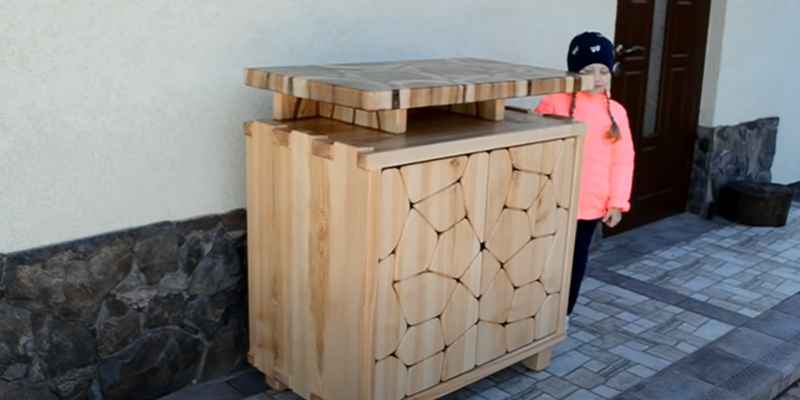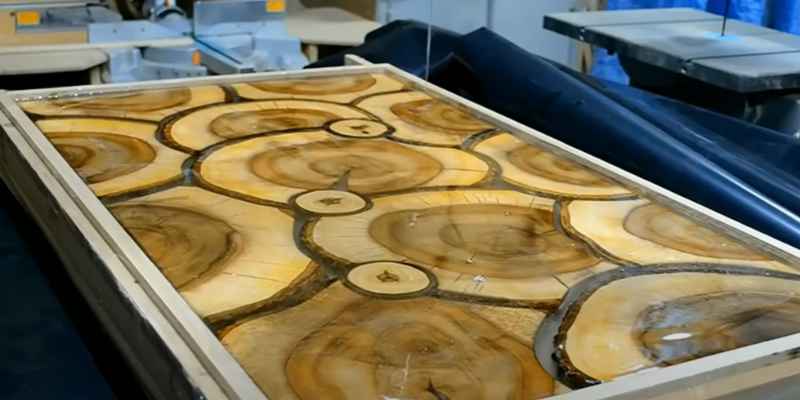Ash and walnut are both popular wood choices known for their durability and attractive grain patterns. Ash is characterized by its light color and pronounced grain, while walnut features a rich, dark hue with a fine, even texture.
These contrasting qualities make them a visually appealing combination for various woodworking projects. From cutting boards to furniture pieces, the blend of ash and walnut creates a striking visual impact that appeals to many. The unique characteristics of each wood type complement and enhance the overall aesthetic of the finished product, making them a popular choice for craftsmen and designers alike.
Whether it’s a custom-made coffee table or a handcrafted cutting board, the fusion of ash and walnut offers a timeless and elegant appeal to any woodworking creation.
The Allure Of Ash And Walnut In Wood Design
When it comes to wood design, the combination of ash and walnut offers a unique and timeless appeal. Both ash and walnut bring their own distinct characteristics to the table, creating a harmonious blend of elegance and contrast in furniture and decor.
The Timeless Elegance Of Walnut
Walnut wood exudes a sense of timeless elegance with its rich, dark tones and luxurious appearance. It is highly sought after for its natural beauty and durability, making it a popular choice for high-end furniture pieces and decorative accents.
Ash: A Bright Contrast
Ash wood provides a bright contrast to the deep hues of walnut, adding a touch of lightness and modernity to the overall design. Its light color and prominent grain patterns create a striking visual impact, making it a versatile choice for both traditional and contemporary settings.
ash and walnuttimeless elegance of walnutbright contrast of ash.
Historical Significance And Modern Appeal
Ash and Walnut have a rich history in craftsmanship and continue to captivate with their modern appeal.
Roots In Craftsmanship
Ash and Walnut have been revered for centuries for their durability and versatility in crafting furniture and decor items.
Contemporary Uses And Innovations
Ash and Walnut are now widely used in modern designs, from cutting boards and coffee tables to flooring and wood furniture.

Physical And Aesthetic Characteristics
The combination of ash and walnut wood creates a striking contrast, with ash known for its high material density and streamlined texture, while walnut features rich, dark hues and a fine, delicate grain. This pairing is often used in creating beautiful wood furniture, flooring, and custom-made pieces, adding both physical and aesthetic appeal to any space.
Grain Patterns And Textures
Ash and walnut wood both have distinct grain patterns and textures. The grain of ash wood is usually straight and uniform, while walnut wood has a more irregular and wavy grain pattern. The texture of ash wood is coarse and porous, whereas walnut wood has a smoother and finer texture. These differences in grain patterns and textures make each wood type unique and suitable for different purposes.
Color Contrasts And Complements
The color of ash wood varies from light brown to creamy white, while walnut wood has a rich dark brown color. When paired together, these two wood types create a beautiful color contrast and complement each other perfectly. The cooler toned ash wood can be used as a base for dining tables, and complemented with darker walnut features to add personality.
Usage Of Ash And Walnut Wood
Ash and walnut wood are popular choices for making furniture, flooring, cutting boards, and decorative items due to their durability, strength, and beautiful appearance. The combination of ash and walnut wood can create stunning pieces of furniture, such as coffee tables and sideboards, and add a touch of elegance to any room. These woods can also be used in veneer form to create stunning wall paneling and cabinetry.
In conclusion, the physical and aesthetic characteristics of ash and walnut wood make them versatile materials for various applications. The unique grain patterns, textures, and color contrasts make them an ideal choice for combining together in furniture and decorative pieces. Both woods are strong, durable, and long-lasting, making them a popular choice among woodworkers and homeowners alike.
Popular Ash And Walnut Wood Products
Ash and walnut wood are highly sought after for their durability, versatility, and aesthetic appeal. These two types of wood are commonly used in a wide range of products, from furniture to decorative and functional pieces. Let’s explore some of the popular ash and walnut wood products that stand out in terms of craftsmanship and design.
Furniture That Stands Out
When it comes to furniture, ash and walnut wood are often used to create stunning and durable pieces. The natural beauty and unique grain patterns of these woods make them ideal for crafting high-quality furniture that stands the test of time. From elegant dining tables to stylish chairs and sleek modern desks, ash and walnut furniture pieces add a touch of sophistication to any space.
Decorative And Functional Pieces
Besides furniture, ash and walnut wood are also utilized to craft a variety of decorative and functional items. Cutting boards made from walnut and ash wood not only provide a sturdy surface for food preparation but also add a touch of elegance to the kitchen. Additionally, coffee tables and flooring crafted from these woods bring a warm and inviting atmosphere to any room.
Furthermore, wood stains and veneers made from ash and walnut are popular choices for adding a rich and luxurious finish to surfaces. Whether it’s a wall mount floating desk, a sideboard, or a modern design coffee table, ash and walnut wood products are known for their timeless appeal and exceptional craftsmanship.
The Art Of Mixing Ash And Walnut
When it comes to interior design, combining different wood types can create a visually stunning and harmonious space. One popular pairing is ash and walnut, which blend together seamlessly to achieve a unique and sophisticated look. In this article, we will explore the art of mixing ash and walnut, and provide design strategies for achieving balance and harmony.
Design Strategies
When working with ash and walnut, it’s important to consider the overall design aesthetic and the desired outcome. Here are some design strategies to keep in mind:
- Contrasting Tones: Ash and walnut have distinct color tones, with ash being cooler and walnut having richer, warmer tones. To create a visually striking effect, consider using ash as a base and contrasting it with darker walnut features. This can be particularly effective in dining rooms or living spaces.
- Playing with Grain: Both ash and walnut have unique grain patterns that add character to any piece of furniture or decor. Experiment with showcasing the different grain patterns by incorporating them into your design. For example, you could use ash with a straight grain for the main structure and walnut with a more pronounced grain for accents or detailing.
- Balance in Proportions: Achieving balance is crucial when mixing different wood types. Consider the proportions of ash and walnut in your design to ensure they complement each other. For instance, if you have a large piece of furniture made predominantly of ash, you can incorporate smaller walnut elements to create visual interest.
- Embrace Sculptural Forms: To add personality to your space, consider incorporating sculptural forms made from ash and walnut. These can be in the form of unique chairs, tables, or decorative pieces that showcase the beauty of both woods. The combination of the smooth lines of ash and the rich tones of walnut can create a captivating visual impact.
Achieving Balance And Harmony
When mixing ash and walnut, achieving balance and harmony is essential to create a cohesive and visually pleasing design. Here are some key considerations:
- Color Balance: Ensure that the colors of ash and walnut are balanced throughout the space. This can be achieved by strategically placing ash and walnut elements, such as furniture, accessories, or even flooring, to create a harmonious color scheme.
- Texture Contrast: Take advantage of the different textures of ash and walnut to create contrast and visual interest. For example, pair the smooth and streamlined texture of ash with the rich and grainy texture of walnut for a dynamic and balanced design.
- Proportional Distribution: Distribute the ash and walnut elements proportionally in the space to create a sense of equilibrium. This can be done by strategically placing larger ash pieces alongside smaller walnut accents, or vice versa.
By following these design strategies and focusing on achieving balance and harmony, you can successfully mix ash and walnut to create a visually captivating and harmonious space. Whether you’re designing a cutting board, a coffee table, or even flooring, the combination of ash and walnut is sure to make a statement.

Sustainability And Sourcing
When it comes to ash and walnut wood, sustainability and ethical sourcing are crucial considerations. The practices involved in harvesting these woods have a direct impact on their availability and the environment. Let’s delve into the sustainability and sourcing of ash and walnut wood.
Ethical Harvesting Practices
The harvesting of ash and walnut wood is guided by ethical practices to ensure minimal impact on the environment. This involves selective logging, where only mature trees are felled, allowing younger trees to continue growing and maintaining the ecological balance.
The Impact On Wood Availability
The sustainable harvesting of ash and walnut wood ensures that the availability of these precious resources is not compromised. By carefully managing the harvesting process, the natural ecosystem can thrive, and future generations can continue to benefit from these valuable woods.
Care And Maintenance For Longevity
Ash and Walnut wood furniture can last a lifetime with proper care and maintenance. By following the best practices for upkeep, you can ensure that the beauty of the wood is preserved for years to come.
Protecting The Wood’s Beauty
- Keep furniture away from direct sunlight to prevent fading.
- Use coasters or placemats to protect against water rings and heat damage.
- Dust regularly with a soft, dry cloth to prevent buildup.
- Apply a quality furniture polish to maintain the wood’s luster.
Best Practices For Upkeep
- Inspect furniture regularly for any signs of wear or damage.
- Repair any scratches or chips promptly to prevent further damage.
- Avoid placing heavy objects on the furniture to prevent warping.
- Use a humidifier in dry climates to prevent the wood from drying out.
Future Trends In Ash And Walnut Design
Ash and walnut are two versatile and timeless wood materials that continue to be popular choices in design. As we look ahead to the future, several exciting trends are emerging in the world of ash and walnut design.
Innovations On The Horizon
Designers are exploring innovative ways to incorporate ash and walnut into modern aesthetics. From futuristic furniture pieces to cutting-edge home decor, the blend of these two woods is creating a buzz in the design world.
Blending Tradition With Modernity
- Combining traditional craftsmanship with contemporary design techniques
- Embracing the natural beauty and durability of ash and walnut in modern interiors
- Creating seamless transitions between classic and modern styles
Frequently Asked Questions
Does Ash Go With Walnut?
Yes, ash can go well with walnut. The cooler tones of ash can serve as a great base for dining rooms and can be contrasted with darker walnut features. Adding sculptural forms can enhance the overall personality of the space.
Mixing and matching wood tones can create a visually appealing and unique aesthetic.
What Wood Goes Well With Ash?
Walnut is a good match for ash due to its darker tones and rich color.
What Wood Compliments Walnut?
Ash and walnut can complement each other well, especially when cooler toned ash is used as a base and contrasted with darker walnut features. Other woods that can be paired with walnut include new cherry or even ash with lighter hues.
Mixing woods with similar hues or grains can also work, such as maple and birch or oak and ash.
What Is The Difference Between Ash And Walnut Wood?
Ash wood has dense material and bold pores, with a sleek texture. Walnut wood has even density, fine pores, and a delicate, soft grain.
Conclusion
To summarize, the combination of ash and walnut wood offers a visually appealing and versatile option for various furniture and decor pieces. The cooler tones of ash provide an excellent base for contrasting with the darker walnut features. Mixing and matching these woods can add personality and depth to any space.
Whether it’s a cutting board, coffee table, or flooring, the unique grain patterns and textures of ash and walnut create a beautiful and timeless look. Consider incorporating this stunning wood combination into your next woodworking project for a touch of elegance and sophistication.


